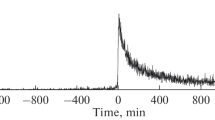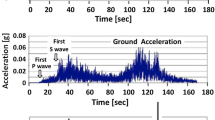Abstract
Although earthquake lights have been known since ancient times, it has not been easy to study them. It was not until the 60s that the first photographs of them were taken. During the Peruvian earthquake in 2007, it was possible to obtain the first film recording on earthquake lights. Likewise, during the earthquakes in Ecuador in 2016 and in Mexico in 2017, two films of the earthquake lights were recorded. These film recordings have helped in the study of earthquake lights, both for their objectivity and for their informational content. Several causal mechanisms have been proposed to explain earthquake lights: piezoelectricity, radon emanation, fluid diffusion, friction-vaporization, positive holes and dipole currents, among others. In this work a time difference correlation between earthquake lights and seismic ground accelerations was found and we use both seismic data and film recordings of earthquake lights to explain its origin. In the discussion section it is suggested that fracturing of rocks manifest itself to some extent in the form of static electricity producing earthquake lights through induction The induction model proposed is new and it can explain the formation of EQL, even if the earth’s crust has layers of large electrical resistivity. The model also explains the formation of seismic lights without the need for special conditions on the earth’s surface or in the atmosphere. A better understanding of the earthquake lights generation process can improve our understanding of seismicity and help in the prediction of earthquakes.
Similar content being viewed by others
References
Bleier, T., Dunson, C., Alvarez, C., Freund, F., and Dahlgren, R., 2010, Correlation of pre-earthquake electromagnetic signals with laboratory and field rock experiments: Nat. Hazards Earth Syst. Sci., 10, 1965–1975.
Chunga, K., Livio, F., Mulas, M., Ochoa-Cornejo, F., Besenzon, D., Ferrario, M.F., and Michetti, A. M., 2018, Earthquake ground effects and intensity of the 16 April 2016 MW 7.8 Pedernales, Ecuador, Earthquake: Implications for the Source Characterization of Large Subduction Earthquakes: Bull. Seismol. Soc. Am., 108, 3384–3397.
Cienfuegos, L., 2016, Luces durante Terremoto en Ecuador 16 Abril 2016: https://www.youtube.com/watch?v=Ddt2BV0CS68.
Derr, J. S., 1973, Earthquake lights: A review of observations and present theories: Bull. Seim. Soc. Am., 63, 2177–2187.
Enomoto, Y., Yamabe, T., and Okumura, N., 2017, Causal mechanisms of seismo-EM phenomena during the 1965–1967 Matsushiro earthquake swarm: Sci. Rep., 7, 1–8.
Freund, F. T., 2007, Pre-earthquake signals-Part II: Flow of battery currents in the crust: Nat. Hazards Earth Syst. Sci., 7, 543–548.
Hayes, G. P., Meyers, E. K., Dewey, J. W., Briggs, R.W., Earle, P.S., Benz, H.M., Smoczyk, G.M., Flamme, H.E., Barnhart, W.D., Gold, R.D., and Furlong, K.P., 2007, M8.0-near the coast of central Peru: USGS, https://earthquake.usgs.gov/earthquakes/eventpage/usp000fjta/executive.
Hayt, W. H., and Buck, J. A., 2012, Engineering Electromagnetics: McGraw-Hill, NY, 45, inside front pages.
Heraud, J. A., and Lira, J. A., 2011, Co-seismic luminescence in Lima, 150 km from the epicenter of the Pisco, Peru earthquake of 15 August 2007: Nat. Hazards Earth Syst. Sci., 11, 1025–1036.
IIUNAM, 2017, Parámetros del Movimiento del Suelo Sismo de Tehuantepec (Mw 8.2) 7 de septiembre de 2017: https://www.eeri.org/wp-content/uploads/Reporte_Preliminar_Sismo_Tehuantepec_07092017.pdf
Jackson, J. D., 1998, Classical Electrodynamics: Wiley, NY, 157.
Jánský, J., and Pasko, V. P., 2018, Earthquake Lights: Mechanism of Electrical Coupling of Earth’s Crust to the Lower Atmosphere: J. Geophys. Res., 123, 8901–8914.
Lira, A., 2008, Time Difference Correlation between Seismic Waves and Earthquake Lights: Seismol. Res. Lett., 79, 516–519.
Luzieux, L. D. A., Heller, F., Spikings, R., Vallejo, C. F., and Winkler, W., 2006, Origin and Cretaceous tectonic history of the coastal Ecuadorian forearc between 1°N and 3°S: Paleomagnetic, radiometric and fossil evidence: Earth and Planetary Science Lett., 249, 400–414.
Michetti, A. M. E. Esposito, B. Mohammadioun, J., Gürpinar, S. Porfido, E. Rogozhin, L. Serva, Tatevossian, R., Vittori, E., 2004, The INQUA scale: An innovative approach for assessing earthquake intensities based on seismically-induced ground effects in the environment, in Special Paper, Memorie Descrittive della Carta Geologica d’Italia, E. Vittori and V. Comerci (Editors), Vol. 67, Servizio Geologico d’Italia- Dipartimento Difesa del Suolo, APAT, Rome, Italy, 120 pp.
Motagh, M., Wang, R., Walter, T. R., Bürgmann, R., Fielding, E., Anderssohn, J., and Zschau, J., 2008, Coseismic slip model of the 2007 August Pisco earthquake (Peru) as constrained by wide swath radar observations: Geophys. J. Int., 174, 842–848.
Nakamura, K. and Tsunenishi, Y., 1966, Ground Cracks at Matsushiro Probably of Underlying Strike-slip Fault Origin, I-Preliminary Report: Bull. Earthquake Res. Inst., 44, 1371–1384.
Palomino, N., 2017, Mexico City EQL 2017: https://www.youtube.com/watch?v=5ELmp4fax6A
Proyecto Survivor, 2007, Luces extrañas en el cielo durante terremoto en Pisco: https://www.youtube.com/watch?v=xPj1xKiVDxU.
Ramírez-Herrera, M. T., Corona, N., Ruiz-Angulo, A., Melgar, D., and Zavala-Hidalgo, J., 2018, The 8 September 2017 Tsunami Triggered by the MW 8.2 Intraplate Earthquake, Chiapas, Mexico: Pure Appl. Geophys., 175, 25–34.
Ruiz, M. and Viracucha, C., 2016, Observaciones del sismo del 16 de abril de 2016 de magnitud mw 7.8. Intensidades y aceleraciones: Informe sismico especial N. 18, https://www.igepn.edu.ec/servicios/noticias/1324-informe-sismico-especial-n-18-2016.
Singh, S. K., Reinoso, E., Arroyo, D., Ordaz, M., Cruz-Atienza, V., Pérez-Campos, X., Iglesias, A., and Hjörleifsdóttir, V., 2018, Deadly Intraslab Mexico earthquake of 19 September 2017 (Mw 7.1): Ground Motion and Damage Pattern in Mexico City: Seismol. Res. Lett., 89, 2193–2203.
Takeuchi, A., Futada, Y., Okubo, K., and Takeuchi, N., 2010, Positive electrification on the floor of an underground mine gallery at the arrival of seismic waves and similar electrification on the surface of partially stressed rocks in laboratory: Terra Nova, 22, 203–207.
Tavera, H., and Bernal, I., 2008, The Pisco (Peru) Earthquake of 15 August 2007: Seismol. Res. Lett., 79, 510–515.
USGS, 2016, M 7.8–27 km SSE of Muisne, Ecuador: https://earthquake.usgs.gov/earthquakes/eventpage/us20005j32/executive#general.
USGS, 2017, M 8.2–101 km SSW of Tres Picos, Mexico: https://earthquake.usgs.gov/earthquakes/eventpage/us2000ahv0/origin/detail
Ye, L., Lay, T., Bai, Y., Cheung, K. F., Kanamori, H., 2017, The 2017 MW 8.2 Chiapas, Mexico, Earthquake: Energetic Slab Detachment: Geophys. Res. Lett., 44, 11824–11832.
Acknowledgments
The authors thank Monica Segovia, Head of the Seismology Area of IGEPN in Quito, and Jorge Aguirre, Coordinator of Seismic Engineering at IIUNAM in Mexico City, for providing seismic data. With regard to the processing of the seismic data special thanks to Guillermo Lira, professor at UNI in Lima. We express our gratitude to the editor and the four referees for the detailed reviews that helped us to improve the manuscript.
Author information
Authors and Affiliations
Corresponding author
Additional information
Antonio Lira is a professor at the Department of Solid State Physics at the Major National University of San Marcos and at the Pontifical Catholic University of Peru. Lira received a Ph.D. in Solid State Physics from Bonn University (Germany). His main research interests include Physics of the Solid Earth and Electromagnetic Monitoring for Pre-Earthqake Signals. E-mail: jlirac@unmsm.edu.pe
Maurizio Mulas, geologist, he graduated from University of Cagliari (Italy) with a B.Sc in Earth Sciences in 2005 and a Master’s degree in Geological Sciences from University of Cagliari (Italy) in 2008 and a PhD in Earth Sciences in 2013. He is now working as Associate Professor in the Faculty of engineering in Earth Sciences (FICT) of Escuela Superior Politécnica del Litoral (ESPOL) of Guayaquil (Ecuador), engaged in geological risk research. His main research interests include geological hazard and geological risk. E-mail: mmulas@espol.edu.ec
Rights and permissions
About this article
Cite this article
Lira, J.A., Mulas, M. Time difference correlation between earthquake lights and seismic ground accelerations. Appl. Geophys. 18, 9–16 (2021). https://doi.org/10.1007/s11770-021-0850-1
Revised:
Published:
Issue Date:
DOI: https://doi.org/10.1007/s11770-021-0850-1




